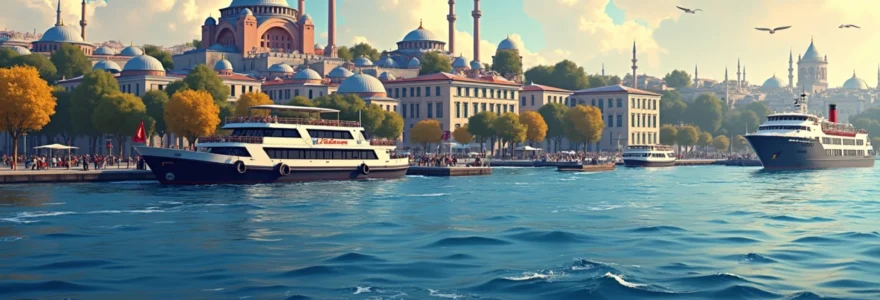Istanbul, a city straddling two continents, stands as a living testament to the harmonious blend of Eastern and Western influences. With its rich history spanning millennia, this vibrant metropolis offers a unique tapestry of cultures, architectures, and traditions that captivate visitors from around the globe. From Byzantine churches transformed into Ottoman mosques to fusion cuisine that tantalises the taste buds, Istanbul embodies the essence of where East truly meets West.
Byzantine and ottoman architectural fusion in istanbul’s skyline
The skyline of Istanbul is a mesmerising panorama that showcases the city’s architectural evolution through centuries. Domes and minarets punctuate the horizon, creating a silhouette that is unmistakably Istanbul. This visual feast is the result of a long history of cultural exchange and conquest, where Byzantine and Ottoman styles have merged to create something truly unique.
Hagia sophia: epitome of East-West architectural amalgamation
Standing at the heart of Istanbul’s historical peninsula, the Hagia Sophia is perhaps the most iconic symbol of the city’s East-West fusion. Originally built as a Byzantine cathedral in the 6th century, it was later converted into a mosque following the Ottoman conquest. Today, it serves as a museum and mosque, showcasing stunning Byzantine mosaics alongside Islamic calligraphy. The massive central dome, supported by pendentives, represents a revolutionary architectural achievement that influenced both Eastern and Western building designs for centuries to come.
Blue mosque: ottoman grandeur with byzantine influences
Directly facing the Hagia Sophia stands the magnificent Sultan Ahmed Mosque, commonly known as the Blue Mosque. Built in the early 17th century, this Ottoman masterpiece incorporates elements of both Islamic and Byzantine architecture. The mosque’s six minarets and cascading domes create a harmonious silhouette, while the interior is adorned with over 20,000 handmade İznik tiles in various shades of blue, giving the mosque its popular name. The spatial concept and dome structure show clear influences from the nearby Hagia Sophia, exemplifying the cultural dialogue between East and West.
Topkapi palace: blending seljuk, ottoman, and european styles
The sprawling Topkapi Palace, once the heart of the Ottoman Empire, is a treasure trove of architectural styles spanning several centuries. As you wander through its courtyards and pavilions, you’ll notice the evolution of Ottoman architecture, from early Seljuk influences to later European-inspired elements. The Harem section, in particular, showcases intricate tile work and ornate decorations that reflect the palace’s role as a melting pot of cultures. The Treasury houses priceless artefacts from across the empire, further highlighting Istanbul’s position as a crossroads of civilisations.
Culinary crossroads: turkish cuisine’s East-West synthesis
Istanbul’s culinary scene is a delightful reflection of its geographical and cultural position. Turkish cuisine itself is a fusion of Central Asian, Middle Eastern, and Balkan influences, further enriched by Ottoman imperial kitchen traditions. In Istanbul, you’ll find this rich culinary heritage seamlessly blending with modern European techniques and presentations.
Spice bazaar: aromatic hub of eastern and western flavours
The Spice Bazaar, also known as the Egyptian Bazaar, is a sensory overload that perfectly encapsulates Istanbul’s role as a culinary crossroads. Here, mounds of colourful spices from the East sit alongside European herbs and local Turkish delicacies. The air is thick with the aroma of cumin, saffron, and cinnamon, while vendors offer tastes of lokum (Turkish delight) and dried fruits. This bustling marketplace has been a centre of spice trade since the 17th century, connecting the flavours of the Silk Road with European tastes.
Meyhanes: traditional taverns serving raki and mezze
For a truly authentic Istanbul dining experience, look no further than the city’s meyhanes. These traditional taverns serve raki, the anise-flavoured national drink of Turkey, alongside an array of mezze (small dishes). The mezze tradition, similar to Spanish tapas or Greek meze, reflects the shared culinary heritage of the Eastern Mediterranean. However, Istanbul’s meyhanes often incorporate unique local twists, such as serving Black Sea anchovies or Aegean wild greens, creating a dining experience that is distinctly Turkish yet familiar to Western palates.
Fusion restaurants in karaköy: modern interpretations of Turkish-European cuisine
In recent years, Istanbul’s Karaköy neighbourhood has emerged as a hotspot for innovative fusion cuisine. Here, talented chefs are reimagining traditional Turkish dishes with modern European techniques and presentations. You might find manti (Turkish dumplings) served with a foam sauce, or a deconstructed baklava paired with ice cream infused with Turkish coffee. These culinary experiments not only showcase the versatility of Turkish cuisine but also highlight Istanbul’s ongoing role as a place where Eastern and Western flavours continue to meld and evolve.
Bosphorus strait: geographical and cultural divide
The Bosphorus Strait is more than just a waterway separating Europe and Asia; it’s the lifeblood of Istanbul and a symbol of the city’s unique position bridging two continents. This narrow strait has been a strategic waterway for millennia, witnessing the rise and fall of empires and serving as a conduit for cultural exchange between East and West.
Ortaköy mosque: Baroque-Ottoman architecture on the european shore
Perched on the European shore of the Bosphorus, the Ortaköy Mosque is a stunning example of the late Ottoman architectural style, which incorporated significant European Baroque influences. Built in the 19th century, its delicate minarets and ornate façade create a picturesque scene against the backdrop of the Bosphorus Bridge. The mosque’s interior features intricate calligraphy and stained glass windows, showcasing the Ottoman Empire’s ability to blend Islamic traditions with European artistic styles.
Maiden’s tower: legendary landmark straddling two continents
Rising from a tiny islet at the southern entrance of the Bosphorus, the Maiden’s Tower is steeped in legend and history. This iconic structure has served various purposes over the centuries, from a lighthouse and defence tower to a quarantine station. Today, it houses a restaurant offering panoramic views of both the European and Asian shores of Istanbul. The tower’s architecture reflects various periods of Istanbul’s history, with Byzantine foundations supporting an Ottoman-era superstructure, making it a true symbol of the city’s layered heritage.
Bosphorus bridge: symbolising istanbul’s transcontinental identity
The Bosphorus Bridge, officially known as the 15 July Martyrs Bridge, is a modern marvel that physically connects Europe and Asia. Completed in 1973, this suspension bridge spans 1,560 meters and serves as a powerful symbol of Istanbul’s role as a transcontinental city. At night, the bridge is illuminated with an ever-changing light show, creating a mesmerising spectacle that can be seen from many vantage points along the Bosphorus. For many Istanbulites, crossing the bridge daily for work or leisure is a tangible reminder of their city’s unique geographical and cultural position.
Bazaars and shopping districts: merging traditional and modern commerce
Istanbul’s commercial landscape is as diverse as its cultural heritage, offering a fascinating mix of traditional bazaars and modern shopping districts. This blend of old and new, Eastern and Western, creates a unique shopping experience that caters to all tastes and budgets.
Grand bazaar: ancient trading hub with 4,000 shops
The Grand Bazaar, or Kapalıçarşı in Turkish, is one of the oldest and largest covered markets in the world. With a history dating back to the 15th century, this labyrinthine complex houses over 4,000 shops spread across 61 covered streets. Here, you can find everything from handwoven carpets and traditional ceramics to designer jewellery and leather goods. The bazaar’s architecture, with its domed roofs and intricate frescoes, is a testament to Ottoman craftsmanship. Haggling is still practised here, adding an authentic touch to the shopping experience and connecting visitors to centuries-old trading traditions.
İstiklal avenue: european-style shopping boulevard in beyoğlu
In stark contrast to the Grand Bazaar, İstiklal Avenue offers a more European shopping experience. This bustling pedestrian street in the Beyoğlu district stretches for nearly 1.4 kilometers and is lined with a mix of international brand stores, local boutiques, and historic buildings. The avenue’s architecture reflects its cosmopolitan past, with Art Nouveau facades housing modern retail spaces. As you stroll down İstiklal, you might catch the nostalgic tram that runs its length, adding a touch of old-world charm to this thoroughly modern shopping destination.
Nişantaşı: high-end fashion district blending turkish and international brands
For luxury shopping with a distinctly Istanbul flair, look no further than Nişantaşı. This upscale neighbourhood is home to both international designer boutiques and high-end Turkish fashion brands. The area’s elegant 19th-century buildings now house chic cafes, art galleries, and exclusive shops. Nişantaşı exemplifies Istanbul’s ability to blend local and global influences, offering a shopping experience that is both sophisticated and uniquely Turkish. Here, you might find a boutique selling handcrafted Turkish leather goods next door to a flagship store of an international luxury brand, perfectly encapsulating Istanbul’s East-meets-West ethos.
Religious diversity and coexistence in istanbul’s neighbourhoods
Istanbul’s rich history as a melting pot of cultures is perhaps most evident in its diverse religious landscape. The city has long been home to various faith communities, each contributing to the unique tapestry of Istanbul’s social fabric. This religious diversity is not just a historical footnote but a living reality in many of the city’s neighbourhoods.
Fener-balat: historic greek orthodox and jewish enclaves
The adjacent neighbourhoods of Fener and Balat on the Golden Horn offer a glimpse into Istanbul’s multicultural past and present. Fener has been the seat of the Greek Orthodox Patriarchate since the 16th century, and the imposing Church of St. George still serves as the patriarchal cathedral. Nearby, Balat was historically home to a significant Jewish population, with several synagogues still active in the area. Today, these neighbourhoods are known for their colourful Ottoman houses, trendy cafes, and antique shops, creating a unique atmosphere where past and present seamlessly coexist.
Kumkapı: armenian quarter with st. mary’s church
Kumkapı, located near the Sea of Marmara, has been the heart of Istanbul’s Armenian community for centuries. The neighbourhood is centred around the Armenian Patriarchate and the impressive St. Mary’s Church, which dates back to the 17th century. Walking through Kumkapı’s narrow streets, you’ll find traditional Armenian restaurants serving specialties like topik (a vegan appetiser) and su böreği (a layered pastry), alongside fish restaurants that cater to a diverse clientele. This area exemplifies how different communities have maintained their distinct identities while contributing to Istanbul’s overall cultural mosaic.
Beyoğlu: multicultural district home to neve shalom synagogue and st. anthony of padua church
Beyoğlu, formerly known as Pera, has long been Istanbul’s most cosmopolitan district. This area is home to significant religious sites representing various faiths. The Neve Shalom Synagogue, the largest synagogue in Istanbul, serves the city’s Sephardic Jewish community. Just a short walk away, the St. Anthony of Padua Church, a stunning example of neo-Gothic architecture, caters to the local Catholic population. These places of worship stand alongside mosques and secular buildings, creating a vivid picture of Istanbul’s religious diversity. The coexistence of these different faith communities in Beyoğlu is a testament to Istanbul’s long-standing tradition of tolerance and multiculturalism.
As we’ve explored, Istanbul’s unique position as a bridge between East and West is evident in every aspect of the city, from its skyline to its cuisine, its bazaars to its diverse neighbourhoods. This captivating metropolis continues to evolve, embracing its rich heritage while looking towards the future, ensuring that Istanbul remains a place where the dialogue between East and West is not just historical but an ongoing, living reality.


